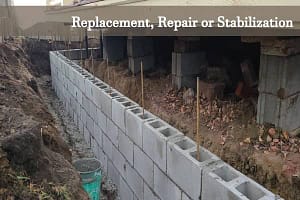The Definitive Guide to Best Basement Waterproofing
The Definitive Guide to Best Basement Waterproofing
Blog Article
What Does Best Basement Waterproofing Mean?
Table of ContentsThe smart Trick of Best Basement Waterproofing That Nobody is Talking AboutThe 9-Second Trick For Best Basement WaterproofingUnknown Facts About Best Basement WaterproofingThe Facts About Best Basement Waterproofing RevealedSome Known Details About Best Basement Waterproofing
usages excavation techniques toward all-time low of the structure's structure. entails getting rid of moisture after it has gone into the basement. AdvantaClean's skilled experts and specialists will certainly situate the water resource. If wall surface or piece cracks exist, we will certainly inject polyurethane and epoxies into the cracks and secure the compromise, protecting against more wetness from going into.If there's condensation outside of the aluminum foil, you have high humidity in your cellar. Fix it with a portable space dehumidifier or a whole-house humidifier system rather of waterproofing items. If the aluminum foil has condensation on the within surface area (beside the wall surface), the dirt around your residence might be naturally damp from a high water table or inadequate dirt drainage.
You can waterproof just your interior walls, which may fix the problem. Once they dry, they adhere completely to concrete and stonework walls.
Get This Report on Best Basement Waterproofing
Concrete waterproof finishes can't be used to previously repainted surface areas; check the label. Recognized as densifiers, they are suitable just for wall surfaces that haven't been repainted or secured.
You comb, roll, or spray it on a lot even more heavily one gallon covers simply 75 square feet, not the 300 square feet common with conventional paint. Water-proof paint is fine for DIY application. You can apply it over repainted surface areas, and paint over it once it's treated (one gallon expenses $37).
It can cost $10,000 to $15,000, relying on the work required. Exterior waterproofing includes digging deep into all over your house to the complete depth of the structure walls, then installing a waterproof layer or membrane covered by drainage panels. The panels give a simple path for water to flow down to an exterior French drain at the bottom of your structure.
We've all been captured in a storm without any umbrella or raincoat (Best Basement Waterproofing). And it's constantly a dish for calamity: everything's wet, your hairdo is ruined, and things are getting stuffy. A basement without waterproofing is type of like that. Minus the spoiled hairdo part. Your cellar does not wish to go with a downpour without correct defense equally as high as you don't wish to.
The Facts About Best Basement Waterproofing Revealed
If you have actually done your research, you would certainly understand there are two kinds of waterproofing: interior and outside. It can get perplexing what they both mean, which one's a far better investment, and what will in fact keep the water out. Do not stress, we created this blog to quickly specify both methods for you and discuss the pros and disadvantages of each.
Exterior waterproofing is a waterproofing approach that entails sealing your home from the outside. It's kind of like a moat around a castle. It involves digging a trench around your entire residence to the structure (regarding 8 to 10 feet down). The structure walls are then cleansed, secured, and covered with a water resistant membrane or sealant.

The 6-Second Trick For Best Basement Waterproofing
It's a much more engaged process that requires digging up your lawn, which is costly and lengthy. Exterior waterproofing includes removing everything bordering the home, including decks, driveways, sidewalks, landscape design, AC devices, decks, and more. If any one of the job was done incorrectly and water is still entering your cellar, there isn't much you can do to fix or fix it.
Interior cellar waterproofing entails waterproofing from the inside. Any water that leaks into your basement is redirected prior to it touches your floor.
It's an efficient technique to waterproof your basement - Best Basement Waterproofing. The drawback of indoor basement waterproofing mainly concerns the installment process. This technique requires saved items, furniture, Find Out More and built-in shelving or cabinets to be moved from touching the cellar wall surfaces. And throughout installation, your cellar can not be utilized. The most significant distinction between both methods is this: Exterior waterproofing is a preventative remedy and interior waterproofing is a rehabilitative service.
The 4-Minute Rule for Best Basement Waterproofing
To conclude, outside and indoor basement waterproofing are both reliable approaches of protecting your home from water damages. Outside waterproofing develops a barrier that prevents water from entering your home, while interior waterproofing reroutes water that does enter your home. And it is very important to keep in mind that exterior waterproofing is a pricey and turbulent installment process when contrasted to interior waterproofing.
Whichever approach you choose, see to it you pick a trusted and credible contractor for the work. Both methods need knowledgeable employees to handle the task. If you have any type of inquiries about basement waterproofing, please connect click for info to us. And if you're in our solution location and have water in your cellar, click now call us for a totally free, no-obligation home assessment.
You can fill in our kind here, start a conversation in the bottom right-hand corner, or call us at 1-800-827-0702.
Report this page